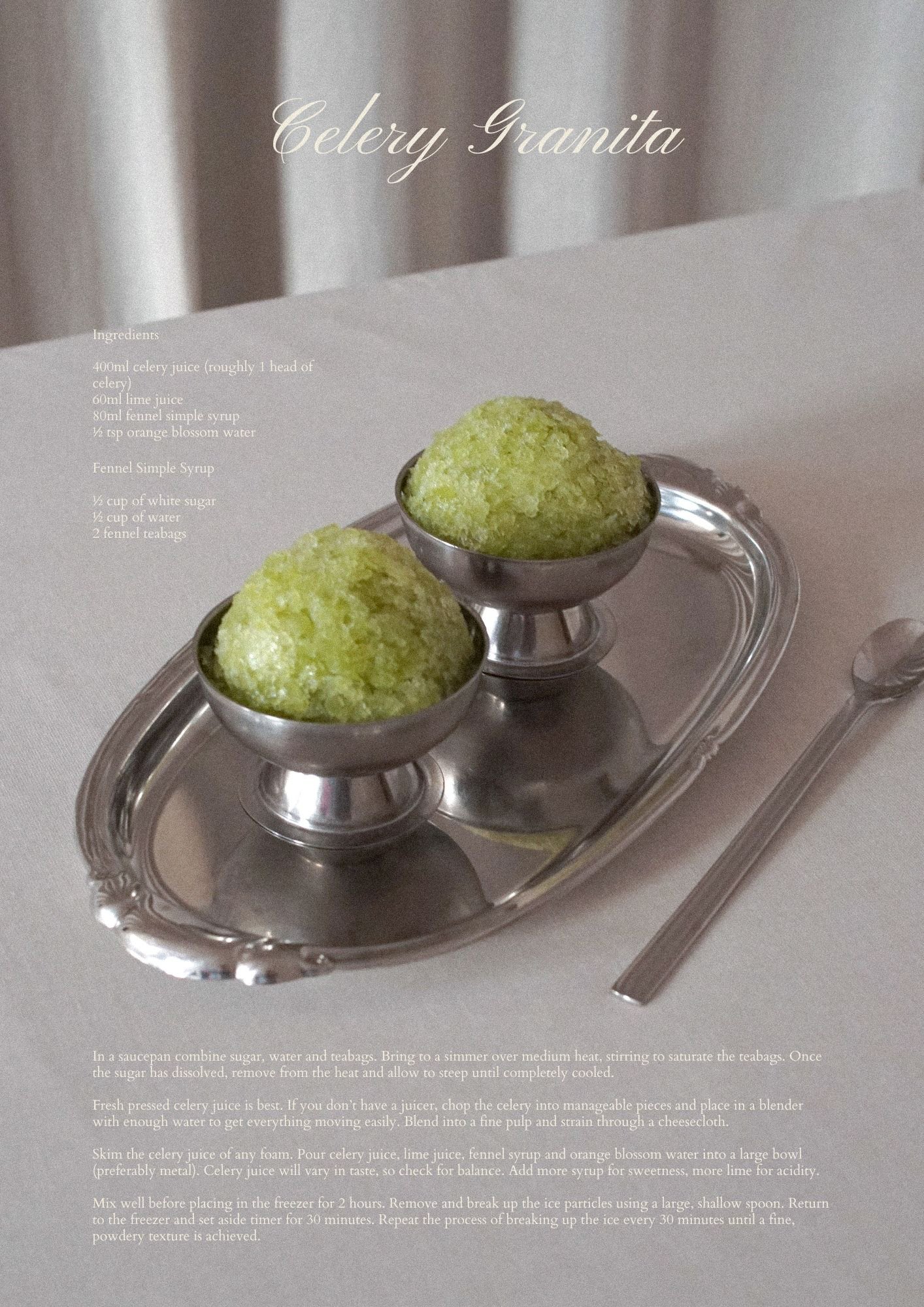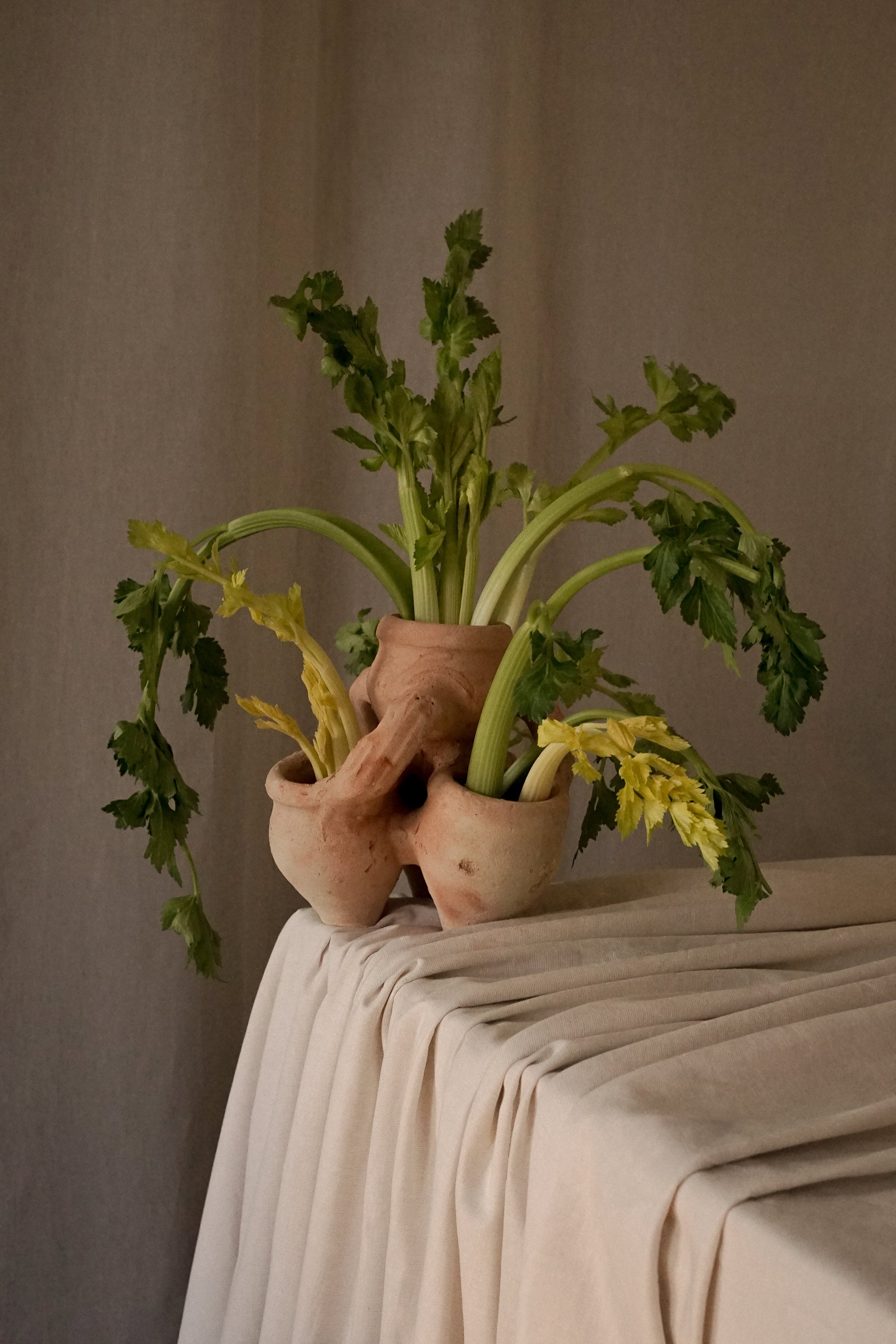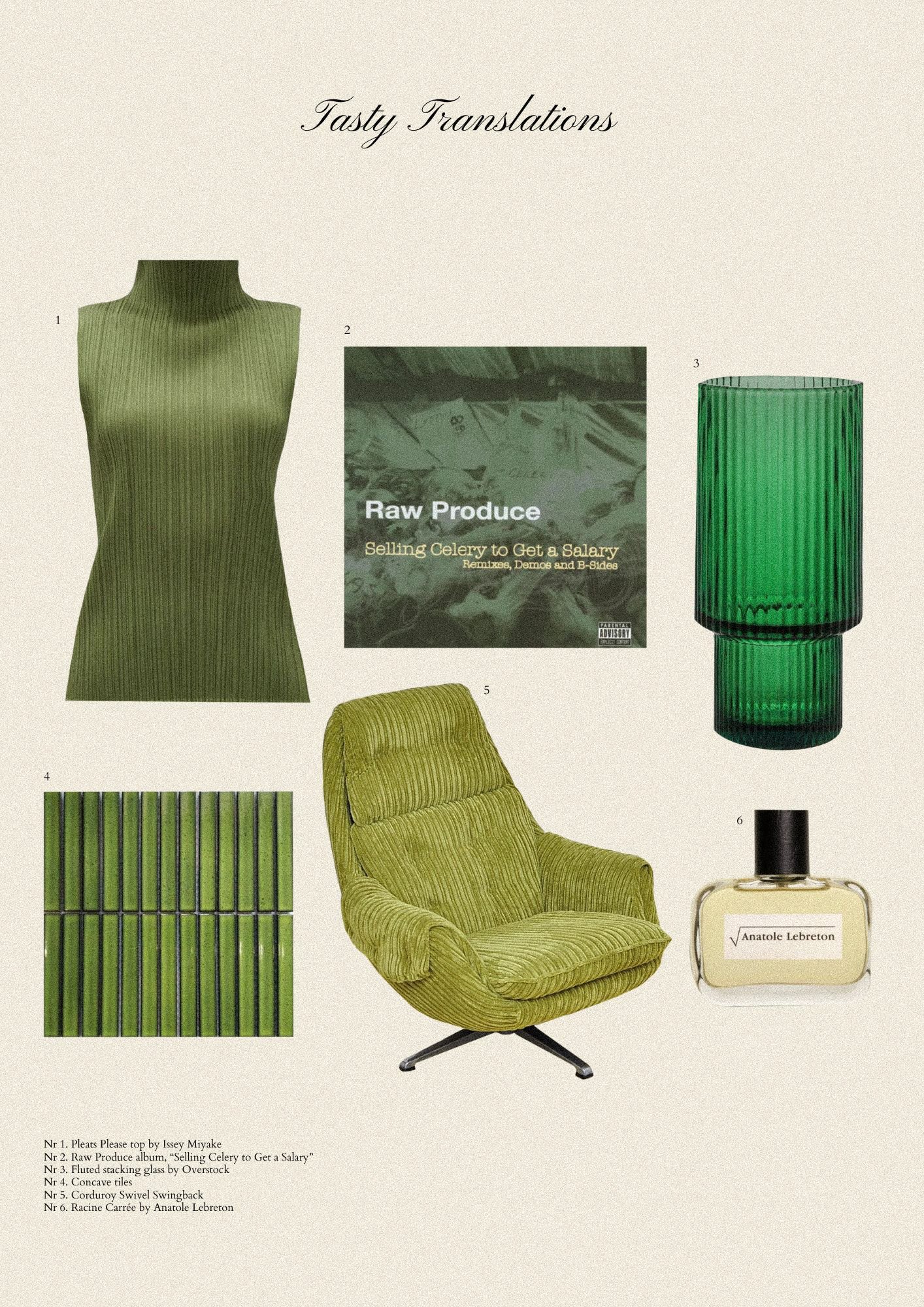Celery, A Crate Study.
Despite its quiet demeanor, celery has a wild history that could rival any trending vegetable today (move over, cucumber). Preserved celery can be traced as far back to ancient Egypt, where it was ritually used in Kemet burials. King Tutankamun’s tomb was adorned with floral garlands woven from papyrus, blossoms, blue faience beads, and celery leaves. However, it was the ancient Greeks who truly embraced the celery craze. Its beginnings were medicinal, and in its earliest form bore a striking resemblance to its cousin, parsley. Its taste was more bitter, more intense than we know today, with an odor so pungent it was believed to have purification properties, aiding in the passage between life and death. Don’t believe me? Here’s Hades and Persephone, sporting a stalk of celery.
Pinax with Persephone and Hades Enthroned, 500-450 BC, Greek, terracotta
A Greek colony in classical Sicily even named an entire city after it, now modern-day Selinunte, where celery still grows wild and abundantly. The humble herb quickly grew in popularity as a flavouring agent, travelling throughout the Mediterranean basin before reaching 15th century horticulturalists in France. Through selective breeding, they reduced some of its bitterness and developed a technique called blanching, where stalks were covered partially with paper or soil to deter sunlight, resulting in sweeter, more tender stalks.
Its cultivation was labour-intensive, making it rare and expensive on the market. Like most rarities, it became a symbol of wealth among Victorian high society and swiftly secured its place as a 19th-century delicacy. A first-class voyager aboard the R.M.S. Titanic could order a serving of celery from the dinner menu, and any well-to-do banquet host would display it proudly as a centerpiece, in an ornamental celery vase made of cut-crystal.
Fast forward to your local supermarket to witness the once-noble celery now dressed in cheap plastic, its prized plumage beheaded for packaging convenience. It’s a mere bullet point on your grocery list - a promise of homemade stock that we all know will never happen. It gets thrown into the basket anyway (because, health) but deep down, we fear its true fate. A slow, quiet banishing to the back of the fridge. Occasionally, the guilt forces you to snap off a stalk or two, but even then it’s outshined by the dips: the sidekick to hummus, the questionable vessel for peanut butter. Sometimes, raisins are involved.
So how did celery fall from quiet luxury to the most silent vegetable on the supermarket shelf? Agricultural advances made it commonplace and affordable - synonyms for ordinary. Its bitter bite, teeth-trapping stringiness, and infamous attachment to diet culture made it polarizing. But look beyond first impressions and you’ll find a vegetable of remarkable complexity, one that deserves more than just a supporting role in your soups, salads and stuffings.
Celery’s last resurfacing was the 2019 wave of the Celery Juice Movement. It was advertised as a cure-all for chronic illness by “Medical Medium” Anthony William, whose 5 million social media followers single-handedly put celery back on the map and into everyone’s glass - including mine. Now, I’m no nutritionist, but anyone with pause would understand that there’s no such thing as miracle juice. What I can attest to is that it is indeed mighty tasty (to my taste buds at least), quenches the thirst and contributes a fraction of my daily nutrients. A glass of green to start the day sounds really good, but I won’t deny that a celery cocktail sounds even better.
Celery juice is bitter, but in a gentle, almost bitter-lemon kind of way that feels hydrating. Good celery should also be slightly sweet and mostly herbaceous. You should also notice a natural salinity, and an anise undertone that’s barely there. Together, these tasting notes create a refined drinking experience: shake with lime for acidity, black pepper syrup to compliment the saltiness, and gin to unify the botanicals - and you have a conversation starter in a coupe glass.
Inspired by the celery-scented hills of Selinunte, why not take that celery juice a step further and turn it into a refreshing Sicilian-style granita for those sweltering summer days? I suggest a fennel tea simple syrup to enhance the anise notes and a few drops of orange blossom water to echo the flavours of a Sicilian fennel and orange salad I’m currently obsessed with. With minimal effort, and a bit of patience with the freezer, you’ll soon be spooning up crunchy celery crystals, feeling like you’ve just unlocked the secret to summer.
As a food stylist, I’ve been eager to get my hands on a celery vase. They’re dotted around reselling platforms like eBay and Etsy, apparently UK charity shops are cluttered with them. But I’m holding out for my upcoming trip to the US, hoping to stumble upon one in the thrift wild. To substitute, I sourced a 4-headed amphora plant pot and set the tablescape by pleating an oversized white tablecloth, mimicking the drapes of a Grecian robe. I separated the stalks of a head of celery and arranged them, somewhat haphazardly, into a celebratory celery centerpiece that Persephone herself would approve of.
But the celery vase quest didn’t stop there. I visited four different supermarkets, each at a different price point, to observe how celery was being presented to the public. Three out of four sold celery without its leaves, likely to maximize shipping space. Two offered package-free celery, with separate paper bags if needed. One was wrapped in a plastic sleeve, while another was held together by a flimsy plastic band.
Now, I’ll be the first to admit I’m far from living a zero-waste lifestyle, but nothing irks me more than plastic packaging that’s first, an eyesore, and secondly, completely unnecessary. I appreciated the supermarkets that had optional paper bags because you know what? Sometimes you just need a bag. In my household, bags are reused numerous ways, from housing my paper recycling to improvised wrapping paper (so bonus if it’s pretty).
As a simple design exercise, I traced a few celery vases to print onto prototype bags. The idea was to replicate an actual vase, making the foliage appear as if it were blooming out of it. I’d say the outcome was quite successful - and after sharing the idea on social media, I can confirm that thousands of shoppers would be swayed to pick up a head of celery more often. And it doesn’t have to stop at celery. Leafy herbs, carrots, rhubarb, chard, leeks, or any tall vegetable would look dapper in these too.
If you run a market of any kind and see the vision, email me: menubyoven@gmail.com
As a closing chapter to the Crate Study, I set out to uncover whimsical celery references in popular culture. Drawing from my former fashion days (I’m a textile engineer on paper), it became humorously apparent how celery crept its way into the groves of pressed pleats or the distinctive ridged texture of corduroy. Luxury fashion house Moschino made a 1:1 replica of celery in leather clutch form. You’ll find celery in the repetitive draping of floor-to-ceiling curtains or perhaps the fluted glass panels of a display cabinet. A bespoke Portuguese tile company crafts concave green tiles that resemble neatly sliced celery stalks, while artisan perfumers develop niche celery scents for those longing to smell like earthy root vegetables.
And of course, it wouldn’t be a full sensory experience without music. Venturing down a Spotify rabbit hole, I stumbled upon a long-lost ‘90s hip-hop duo aptly named Raw Produce. Their album Selling Celery to Get a Salary has not only been playing on repeat, but has also become somewhat of a personal mantra of mine.
If you made it this far, then I think I’ve found my people and I’d love to bombard you with the occasional love letter to forgotten fruit and vegetables. If you’re a reader, subscribe to my newsletter down below. If you’re more of a visual learner, you’re welcome to join my digital table anytime @menubyoven
Who is this Crate Study for? Ideally, fruit and vegetable producers in need of creative direction, a fresh campaign idea or a brand identity before launching a new variety to market.
If that sounds like you, let’s talk: menubyoven@gmail.com








